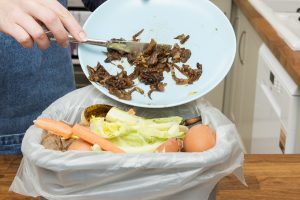Food Waste
 The obsession with idealistic or perfect food results in 27% of food being wasted in Canada alone. While our 13 million tonnes of food waste seems tiny compared to the 126 million tonnes of food that is wasted in the US, Canadians waste 396 kg of food per person per year, compared to the American 415 kg and and Mexican 249 kg (1).
The obsession with idealistic or perfect food results in 27% of food being wasted in Canada alone. While our 13 million tonnes of food waste seems tiny compared to the 126 million tonnes of food that is wasted in the US, Canadians waste 396 kg of food per person per year, compared to the American 415 kg and and Mexican 249 kg (1).
Food waste occurs at every step of the food system, but mainly at
- production
- retail
- home
A major reason for this waste is that the grading system leads to many good fruits and veggies being thrown out, simply because they are deformed. (Think about home grown garden carrots that come in all shapes and sizes – they’re delicious, despite looking a little funky.) Additionally, to achieve a standard look, a large amount of chemical inputs (such as pesticides) are used.
Here is a basic breakdown and reasons for food waste at five different stages (1):
- 29% pre-harvest – overproduction and surplus (results in food rotting in fields)
- 10% post harvest – grading standards for size and quality; order cancellations
- 11% processing – damage during production; inefficient machinery; contamination
- 7% distribution – damage during transportation; does not achieve market standards
- 43% consumer – over-preparing; improper handling and storage
It is not only the food that is wasted, but also the resources that went into the initial production. For example, all the wasted food in the US adds up to 22 million hectares of wasted cropland per year (the size of Utah)!
As well, wasted food means that essentially 25% of the water used in agriculture is also wasted. Read more about food waste in this document.
Easy & Effective Solutions:
- Avoid “buy 1 get 1 free” deals if you know you won’t be able to eat all that food.
- Support grocery stores or local markets that sell “ugly” food. As long as it is still good to eat, food doesn’t have to look conventional to be tasty!
- Plan your meals one week at a time to avoid buying too much food.
- Check your fridge and pantry before going to the grocery store to ensure you don’t buy something you already have.
- Get creative with your leftovers!
- Compost any unavoidable food waste.
Food Fads
 To keep low consumer costs, many foods are imported from developing countries, where farmers are paid far less for the same goods that Canadian farmers produce. These cheaper alternatives lead to local farmers in Manitoba having a harder time entering the market with their fair wages. Furthermore, These social costs, as well as animal welfare, often guide people in their diet decisions. With this improved consciousness, health foods are increasingly common.
To keep low consumer costs, many foods are imported from developing countries, where farmers are paid far less for the same goods that Canadian farmers produce. These cheaper alternatives lead to local farmers in Manitoba having a harder time entering the market with their fair wages. Furthermore, These social costs, as well as animal welfare, often guide people in their diet decisions. With this improved consciousness, health foods are increasingly common.
While being more health conscious often leads to more climate-friendly choices, there are also downsides to following food fads. (Click here to read up on quinoa and chia seeds.) For one, due to the food system set-up, access to such “ethical” or health foods are often at a higher price that is only available to certain income levels (read more here).
As the social costs are another incredibly complex topic, we will now just stick to the environmental costs.
Quick solutions to food fads: Assessing food fads for production, processing, and transportation emissions is important in making a climate-friendly decision. Looking for local alternatives to global fads is a great way to reduce your “food-print”.
Food Miles
 The distance food must travel from farm to fork is commonly referred to as “food miles”. Transporting food from around the world contributes approximately 10% of food system emissions.
The distance food must travel from farm to fork is commonly referred to as “food miles”. Transporting food from around the world contributes approximately 10% of food system emissions.
When considering what to buy in the store, think about what form(s) of transportation was required, as well as the distance the food travelled. For example, road transportation uses 4x more fuel than rail, and air transportation requires 37x more fuel than shipping. (See the figure below.)
Quick Solution: Buying local food can reduce your family’s food-print by up to 20%.
Consumers are also responsible for generating significant amounts of GHGs just from driving to grocery stores or markets. Therefore, as a consumer, consider how you are picking up your groceries. Perhaps you could bike, walk, or carpool rather than drive.
If driving is your only option, plan your meals a week at a time so that you can take fewer trips to the grocery store.
“Junk” Food
“ Junk” food is considered that which is highly processed and packaged.
Junk” food is considered that which is highly processed and packaged.
Case Study: Let’s consider the carbon footprint of a box of cookies.
The cookies themselves require all the ingredients (sugars, wheat, soy, oils, etc.) to be shipped from their original source to the factory. These raw ingredients are often processed before even reaching the processing factory, such as making palm oil.
Once made, the cookies are packaged into a plastic (sourced from oil) carton and a cardboard box (sourced from trees). There are emissions generated from the transportation of these goods, as well as from the factory processing them.
Additionally, most nutrients that are found in the individual ingredients are lost during processing. Therefore, while they may taste good in the moment, processed foods are not helping people or the environment.
Solution:
Avoid the processed food aisles altogether. If that’s too “cold turkey”, try eliminating or replacing one treat at a time.
Making homemade cookies, for example, allows you to select more sustainable ingredients. Choosing local flours and eggs, palm oil free chocolate chips, and skipping the soy altogether gives you the power to be more climate-friendly.




